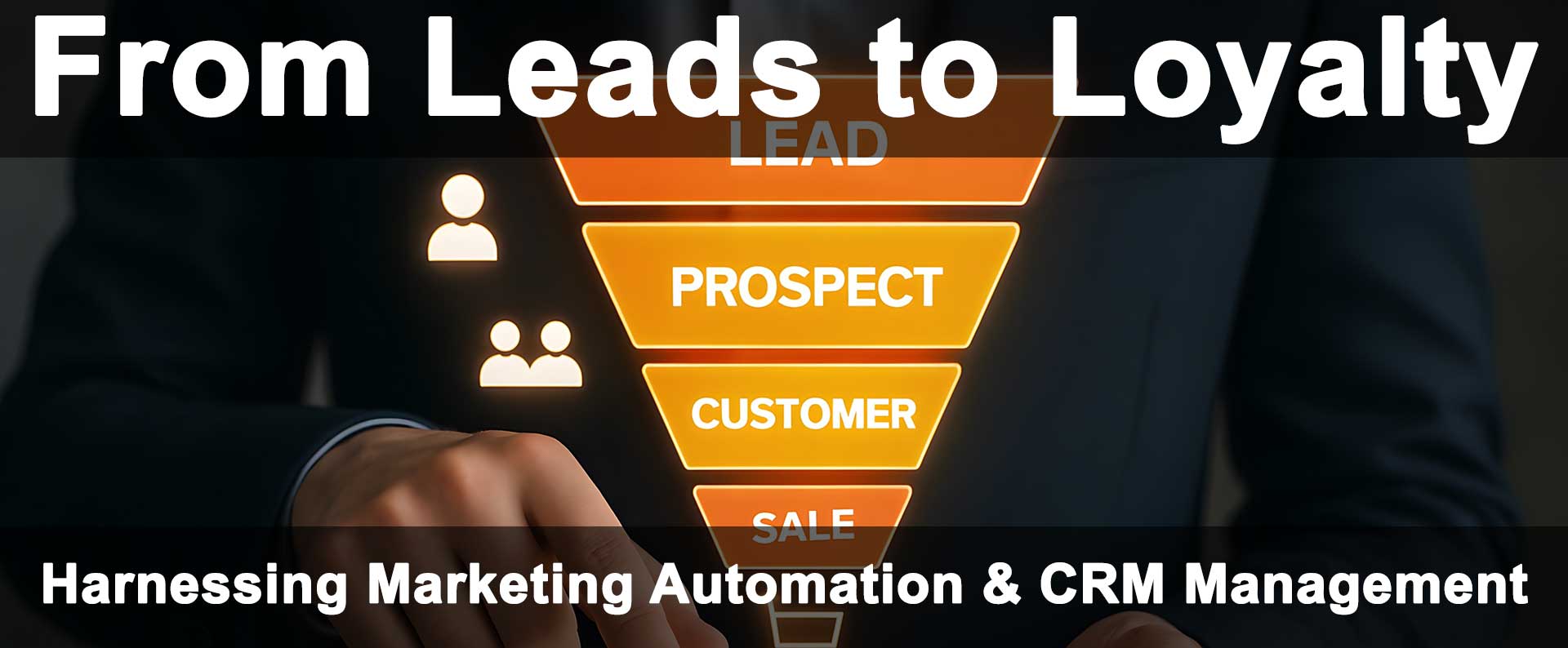Marketing Automation is one of the most powerful tools for Small and Medium-sized Businesses to integrate and avoid a fragmented and disjointed online presence.
It’s not just a buzzword; it's the central nervous system of a modern, multi-channel marketing strategy, seamlessly connecting lead generation and customer relationship management (CRM).
This article will explore how marketing automation acts as a powerful ally to your existing efforts, its critical importance for SMB success across various industries, and actionable steps for implementation.
Understanding Marketing Automation
At its core, marketing automation is technology that manages marketing processes and multifunctional campaigns across multiple channels automatically. For SMBs, its primary power lies in nurturing leads and personalizing customer journeys without requiring constant manual effort.
Think of it this way:
Your Google Ads, social media campaigns, and traditional mailers are excellent at casting a wide net to generate initial interest (leads).
Marketing automation is what takes those captured leads and systematically turns them into paying customers and loyal advocates.
Simply put, marketing automation is software that handles routine marketing tasks automatically. It can send personalized emails based on a user's behavior, score leads based on their engagement, and nurture prospects until they are sales-ready.
A Customer Relationship Management (CRM) system is your single source of truth for all customer interactions, from a first-time website visitor to a loyal, repeat client.
When these two systems work together, magic happens. Every ad click, email open, website visit, and social media interaction is logged against a contact in your CRM. This creates a 360-degree view of each prospect, allowing for hyper-targeted, timely, and effective marketing across every channel.
Why Marketing Automation Matters: Bridging Strategy & Execution
Marketing automation connects disparate marketing channels, ensuring consistency and efficiency. By automating repetitive tasks (e.g., email campaigns, social media posting, lead scoring), SMBs can focus on strategic growth while:
- Reducing Costs:
Automate 70% of repetitive marketing tasks (HubSpot).
- Boosting Conversions:
Targeted workflows increase conversion rates by up to 300% (Marketo).
- Enhancing Customer Retention:
Personalized CRM workflows improve lifetime value (CLV) by 30%+ (Salesforce).
Overall Key Benefits for Any Industry
- Efficiency & Scalability:
Automate repetitive tasks like email responses, social posting, and lead scoring, freeing up your team to focus on strategy and high-touch customer service.
- Enhanced Lead Nurturing:
Move prospects through the sales funnel with targeted content based on their behavior (e.g., downloading a guide, visiting a pricing page).
- Personalization at Scale:
Deliver the right message to the right person at the right time, dramatically increasing engagement and conversion rates.
- Consistent Multi-Channel Experience:
Coordinate messages across paid ads, organic social, email, website, and offline channels (mailers, billboards).
- Closed-Loop Reporting:
By integrating with your CRM, you can finally track which marketing efforts—from a billboard to a Facebook ad—actually generate revenue, not just clicks.
- Measurable ROI:
Link channel spend to pipeline and revenue using an integrated funnel and attribution across touch-points.
- Retention & Lifetime Value:
Automations for onboarding, re‑engagement, and upsell increase retention without constant manual effort.
- Data-Driven Decisions:
By leveraging data analytics, businesses can gain insights into customer behaviors, preferences, and engagement patterns, paving the way for targeted strategies that enhance lead generation and nurture customer relationships.
- Measurable ROI:
How Automation Strengthens Existing Channels
- Digital Ads (Google/Facebook):
Feed ad audiences with CRM segments and use conversion events to retarget or exclude existing customers. Automations trigger nurture sequences after ad click or form submission.
- Social & Content:
Promote gated content and automatically enroll responders in educational drip campaigns.
- Website & Apps:
Behavioral triggers (pageviews, cart abandonment, appointment booking) create real‑time workflows.
- Traditional Channels (print, mailers, billboards, OOH):
Use unique URLs, promo codes, QR codes, or phone numbers tracked into CRM to capture offline leads and start digital nurturing sequences.
- Sales Handoff:
Automation scores leads and routes them to the right person or booking calendar, reducing lead leakage.
Integrating Automation into Your Multi-Channel Marketing Strategy
Marketing automation shouldn't operate in a silo. Its true power is unleashed as a reinforcement tool that unifies all your channels.
Integration into a Broader Marketing Strategy
To maximize ROI, automation must align with overarching goals:
- Align with business objectives: Map automation workflows to key metrics (e.g., lead volume, customer retention).
- Segment audiences: Use CRM data to create dynamic customer profiles.
- Sync channels: Integrate automation with digital (social media, ads) and traditional (print, billboards) campaigns.
General Actionable Integration Steps
To successfully incorporate marketing automation into a broader marketing strategy, SMBs should consider the following actionable steps:
1. Define Goals & Objectives:
- Audit current channels, data sources, and touchpoints (forms, ad platforms, POS, phone, mailers).
- Identify specific lead generation and CRM goals that align with overarching marketing objectives.
- For instance, increasing email conversion rates or improving customer retention can be targeted with specific automation strategies.
2. Choose the Right Tools:
- Choose or confirm a CRM + automation platform that supports integrations you need (Zapier/Make, native connectors to Google Ads/Facebook, call tracking, POS, email/SMS).
- Invest in tools that integrate well with existing platforms, like CRM systems and social media management tools, to ensure a cohesive strategy.
3. Content Strategy:
- Develop a content plan that can be automated across channels.
- Use blogs, whitepapers, and infographics tailored to the audience of each industry served, while ensuring distribution is streamlined via email marketing campaigns or social media posts.
4. Lead Scoring:
- Implement a lead scoring system that identifies which leads are ready for conversion and prioritize outreach efforts accordingly.
- Standardize lead capture fields and UTM/source tagging; implement unique trackables for offline channels (personalized URLs, QR, promo codes, tracking phone numbers).
- Define lead lifecycle stages, scoring rules, and SLA for sales follow‑up.
5. Engage Across Channels:
- Use automation to ensure consistent messaging across all channels.
- From social media ads to email campaigns, a harmonized approach reinforces branding and improves visibility.
- Build templated automations: welcome, nurture, re‑engagement, appointment reminders, post‑purchase follow up.
- Instrument reporting: funnel visualization, channel performance, conversion attribution, and LTV metrics.
- Run tests, iterate creative and cadence, reallocate spend to highest ROI channels.
Integrated Funneling to Track Conversion Effectiveness
- Capture Leads from Every Channel:
Use your website forms, social media lead ads, and even QR codes on print materials and OOH billboards to feed contacts into your automated system.
- Enrich & Score:
Automatically append third‑party data, apply lead scoring rules (behavior + fit) to prioritize.
- Nurture & Trigger Personalized Journeys:
Channel‑specific sequences (email, SMS, retargeting) tied to lifecycle stage. A lead captured from a specific channel can enter a tailored workflow.
For example, someone who signs up via a QR code on a restaurant's table tent receives a different series of emails than someone who downloaded a construction company's white-paper on their website.
- Sync with Your CRM & Convert:
Trigger booking, invoice, or sales tasks; log conversions in CRM with source/channel metadata. This is non-negotiable.
When your automation platform talks to your CRM, your sales team gets a complete view of the prospect's journey—what emails they opened, what links they clicked—enabling them to have more informed and effective conversations.
- Analyze & Optimize:
Dashboards for channel ROI, funnel drop‑offs, time‑to-conversion, LTV by acquisition source. Use A/B tests and cohort analysis to refine creative and investment.
Industry-Specific Applications & Actionable Steps
Here’s how SMBs in your key industries can leverage marketing automation:
Retail:
- Step 1 (CRM Setup):
Implement a CRM that integrates with your e-commerce platform. Capture customer data at every touchpoint: online purchases, in-store sign-ups for loyalty programs, website visits.
- Step 2 (Automated Welcome Series):
When a new customer signs up for your newsletter or makes their first purchase, trigger a 3-part welcome email series:
- Email 1: Thank you, introduce brand story/values, offer a small first-purchase discount.
- Email 2: Highlight popular product categories or bestsellers.
- Email 3: Encourage social media follow-ups or reviews.
- Email 1: Thank you, introduce brand story/values, offer a small first-purchase discount.
- Step 3 (Abandoned Cart Recovery):
If a customer adds items to their cart but doesn't purchase, automatically send a reminder email within 30-60 minutes, potentially offering free shipping or a small discount if they complete the purchase within 24 hours.
- Step 4 (Post-Purchase Follow-up):
After a purchase, automatically send a "thank you" email, ask for a product review, and suggest complementary products based on their purchase history.
- Step 5 (Loyalty & Re-engagement):
Segment customers by purchase frequency. Automatically send special offers to frequent buyers or re-engagement campaigns (e.g., "We miss you!") to those who haven't purchased in a while.
Restaurants:
- Step 1 (CRM & Data Capture):
Use your online reservation system (e.g., OpenTable integration) or a Wi-Fi sign-up form to capture customer emails and names. Integrate this with a simple CRM.
- Step 2 (Welcome & Birthday Offers):
When a new customer provides their email, send an automated welcome email with a special offer (e.g., "10% off your next meal"). Capture birthdays and automatically send a birthday coupon a week before their special day.
- Step 3 (Post-Visit Feedback):
After a customer dines (based on reservation data), automatically send an email asking for feedback or a review on platforms like Yelp or Google.
- Step 4 (Event & Special Promotion Alerts):
Segment customers based on dining preferences (e.g., interested in wine pairings, brunch specials) and send automated emails about upcoming events or promotions relevant to them.
- Step 5 (Loyalty Program Integration):
If you have a loyalty program, automate point updates, reward notifications, and exclusive offers to top-tier members.
Hospitality (Hotels, Resorts):
- Step 1 (CRM Integration):
Ensure your Property Management System (PMS) integrates with your CRM to capture guest data (stay dates, preferences, booking source).
- Step 2 (Pre-Arrival Communications):
After a booking, automate a series of pre-arrival emails:
- Email 1 (Confirmation): Booking details, welcome message.
- Email 2 (Upsell/Experience): Offer room upgrades, spa packages, restaurant reservations, or local tour suggestions.
- Email 3 (Logistics): Directions, check-in instructions, Wi-Fi details, weather forecast.
- Email 1 (Confirmation): Booking details, welcome message.
- Step 3 (In-Stay Engagement):
(More advanced) Send a short survey or message on day two asking "Is everything to your satisfaction?" If a problem is reported, notify staff immediately.
- Step 4 (Post-Stay Feedback & Re-engagement):
After check-out, automate:
- Email 1: Thank you, request a review on TripAdvisor/Google.
- Email 2: Offer a discount code for a future stay, or highlight seasonal packages.
- Email 3: Segment guests by stay type (business, leisure) and send tailored promotions for future bookings.
- Email 1: Thank you, request a review on TripAdvisor/Google.
Construction:
- Step 1 (Website Lead Capture & CRM):
Ensure your website has clear "Request a Quote" forms, and that form submissions automatically create a new lead in your CRM.
- Step 2 (Automated Lead Qualification):
Upon form submission, send an immediate email thanking them and providing a link to an in-depth project questionnaire. If they complete the questionnaire, notify your sales team of a "hot lead."
- Step 3 (Nurture for Non-Ready Leads):
For leads who aren't immediately ready to commit, set up an automated email series:
- Email 1: Case studies of similar projects.
- Email 2: Testimonials and client success stories.
- Email 3: Information on your project process and commitment to quality.
- Email 4: An invitation for a no-obligation consultation.
- Email 1: Case studies of similar projects.
- Step 4 (Project Progress Updates):
(Internal Automation) For active projects, automate internal notifications for key milestones (e.g., "Foundation poured - send client update!").
- Step 5 (Post-Project Follow-up):
After project completion, automate an email asking for a review or testimonial. After 6-12 months, send an automated "check-in" email asking about any maintenance needs or potential future projects.
Healthcare (Clinics, Practices):
- Step 1 (Patient CRM & EMR Integration):
Integrate your Electronic Medical Records (EMR) system with a patient CRM for a comprehensive view of patient data.
- Step 2 (Appointment Reminders):
Automate SMS and/or email appointment reminders 24-48 hours before an appointment to reduce no-shows.
- Step 3 (New Patient Welcome & Onboarding):
For new patients, automate a welcome email series:
- Email 1: Welcome, introduce practice, provide links to patient forms.
- Email 2: Information on services offered, common FAQs.
- Email 3: What to expect at their first visit.
- Email 1: Welcome, introduce practice, provide links to patient forms.
- Step 4 (Post-Appointment Follow-up):
After an appointment, automatically send a follow-up email asking about their experience and inviting them to leave a review.
- Step 5 (Educational & Preventative Care Nurture):
Segment patients based on conditions or age. Automate educational content (e.g., "Tips for managing diabetes," "Importance of annual check-ups") to promote preventative care and patient engagement.
Professional Services (Legal, Accounting, Consulting):
- Step 1 (Lead Capture & CRM):
Use website forms (e.g., "Free Consultation," "Download Whitepaper") to capture leads and automatically add them to your CRM.
- Step 2 (Automated Lead Qualification & Nurture):
- If a prospect downloads a specific legal guide (e.g., "Starting a Small Business"), automate an email series offering more resources, success stories, and an invitation for a consultation.
- If they request a consultation, automatically send a confirmation, a pre-consultation questionnaire, and a reminder.
- If a prospect downloads a specific legal guide (e.g., "Starting a Small Business"), automate an email series offering more resources, success stories, and an invitation for a consultation.
- Step 3 (Client Onboarding):
Once a new client signs on, automate a welcome series outlining next steps, providing essential documents, and introducing their dedicated team members.
- Step 4 (Deadline & Compliance Reminders):
For accounting or legal clients, automate reminders for important filing deadlines, tax season updates, or compliance changes relevant to their business.
- Step 5 (Value-Add Content & Relationship Nurture):
Segment clients by industry or service. Automate the delivery of relevant industry news, legislative updates, or insights that demonstrate your ongoing expertise and value.
Tracking Outcomes: The Integrated Funnel
To evaluate the success of an integrated marketing automation strategy, SMBs should implement tracking mechanisms such as:
- Funnel Analysis:
Monitor each stage of the marketing funnel to understand where leads drop off and optimize those areas for higher conversion rates.
- A/B Testing:
Continuously experiment with different messaging and delivery methods to ascertain what resonates best with each audience segment.
- Analytics Dashboard:
Utilize tools that generate real-time reports on campaign performance, lead engagement, and conversion statistics, allowing for data-driven adjustments.
The ultimate benefit of integration is tracking conversion effectiveness from top to bottom. You can attribute a closed deal back to the original Google Ad, the Facebook post, or the postcard mailer that started the journey. This data allows you to:
- Double down on what works and reallocate budget from underperforming channels.
- Understand your customer's path to purchase in granular detail.
- Prove marketing ROI with concrete numbers, moving from cost center to profit driver.
Measuring Success — Key Metrics to Track
- Lead volume by source and quality (score).
- Conversion rates at each funnel stage (visitor → lead → qualified → customer).
- Cost per acquisition (CPA) by channel.
- Time to convert and velocity through stages.
- Revenue, repeat purchase rate, and LTV by cohort/source.
- Channel attribution (first, last, multi‑touch) to inform budget shifts.
Quick Tech Stack & Tools (Examples)
- CRM + Automation: HubSpot, ActiveCampaign, Keap, Salesforce with Pardot/Marketing Cloud.
- Email/SMS: Twilio, SendGrid, Postmark, Klaviyo (retail focus).
- Ad & Analytics Integrations: Google Ads, Facebook/Meta, Google Analytics / GA4.
- Call & Offline Tracking: CallRail, unique tracking numbers, PURLs/QR codes.
- Integration Middleware: Zapier, Make, native APIs for POS/booking systems.
Final Checklist to Get Started
- Map customer journeys for top 3 services/products.
- Implement unified lead capture and UTM/offline tracking.
- Build 3 core automations: welcome/onboarding, nurture (lead‑to‑sale), and re‑engagement.
- Define lead scoring and SLA for follow up.
- Establish dashboards for channel performance, funnel conversion, and LTV.
- Test, optimize, and scale highest‑ROI channels.
Conclusion: Your Marketing's Central Command
Marketing automation is the force multiplier that SMBs need to compete effectively. It’s the strategic layer that connects your digital and traditional efforts, nurtures leads efficiently, and provides the data-driven insights required for sustainable growth.
Different industries can leverage tailored approaches to drive engagement, increase conversions, and ultimately grow their businesses. By implementing thoughtful automation processes, SMBs will not only remain competitive but also foster deeper connections with customers, ensuring long-term success in a quickly evolving market.
As you consider the integration of marketing automation in your strategy, remember to start small, track your outcomes, and continuously adapt based on insights gathered to maximize the benefits of this essential marketing tool.













